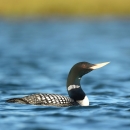States
AlaskaThe mid-continent population of greater white-fronted geese (Anser albifrons frontalis) breeds in tundra habitats from the eastern shore of Hudson Bay to the west coast of northern Alaska, south into boreal forests and taiga habitat in interior and northwest Alaska. The winter range extends through Central and Mississippi Flyway states and into portions of Mexico. Throughout its range, greater white-fronted geese are an important resource for sport and subsistence hunters.
To collect data needed for harvest management of greater white-fronted geese, flocks are captured and leg banded annually throughout Canada and Alaska. Within interior Alaska, our Alaska Migratory Birds Office leads this annual effort in collaboration with National Wildlife Refuges. The objective of this project is to estimate annual survival, harvest rate, and population size. Following the flyway management plan, these estimates are calculated from band and encounter data to determine bag limits and season dates for the subsequent hunting season.
Since 1969, USFWS biologists have banded more than 60,000 mid-continent greater white-fronted geese in major molting areas in Alaska. While banding within Interior and Northwest Alaska occurred in multiple sites annually in the state prior to 2012, recent activities have focused solely on the Innoko National Wildlife Refuge, the terminus of a major molt migration of nonbreeding and failed breeding white-fronts from throughout Interior Alaska.
Banding - Arctic Goose Joint Venture
The Significance of Waterfowl Bands to Hunters and Scientists Alike



